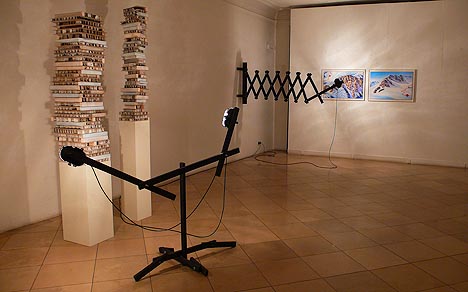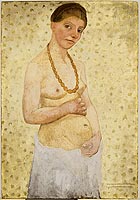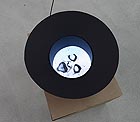
translated and summarized by: Liz Wollner-Grandville,
English summaries May 10 - 17
Kunsthaus Muerz
Wendelin Pressl - Zuschlag
until 23. May 2010
Mind you, the world's still turning
Performance incentives, system directives, ecology and deterioration through globalization are increasingly taken up in contemporary art productions. In the Kunsthaus Muerz gallery, the solo exhibition, "Zuschlag", illustrates a laboratory for field studies, theoretical reflections and experimental working processes. The four rooms are thematically divided between culture, risk, stress analysis, kerosene, calculations and building aggregates. Interplay in a precarious reality evokes contextual interrogation which is medially structured by Wendelin Pressl, born 1971.
Contention with the architectonic space is achieved by dispensing with the on-site light sources. It is essentially developed for the objects from floor lighting or from wall-mounted lighting. The rooms, darkened from outside, mutate into cave-like exhibition chambers for performative rudiments of his work, thereby – with the help of interventions - simultaneously exuding both calculated power as well as the lack thereof.
The basis for success is often geometric forms as, for example, the "Astrodome" which was created in 2006, an emulation of the dome of Rome's Pantheon, with small format photographs of the heavens applied and gyrating from the ceiling of the entrance room to the gallery. A second two-piece work, especially created for the exhibition, consists of concrete, steel and the poured forms of crystal-like mirror shards. Wendelin Pressl lays great value on analogous production processes in which he himself develops, or at least adapts, everything, an example being the two fragile towers, created in 2010 from sawn up table tops piled one upon the other and mounted on white plinths.
Visitors are pressed to comprehend ironic references by the artist, together with their meanings. In doing so, the desire for lightness can deflect from the actual depth of the artistic results. With this formal sobriety, "Zuschlag" leaves a lasting impression.
By Leon Gumil Hainzl
"Zuschlag", until 23 May 2010
Kunsthaus Muerz Gallery
Wiener Strasse 54, A-8680 Mürzzuschlag
www.kunsthausmuerz.at
Kunsthalle Krems
Paula Modersohn-Becker, Pioneer of Modernism
14.03.10 – 04.07.10
“Mouths like wounds, expression like cretins”
If Paula Modersohn-Becker had been a man, the florid style of literature in her time would have described her as a titan. In a time span of only 10 years she created 750 paintings and 1,000 drawings: this representing not only an extensive oeuvre but foremost a visionary one. Modersohn-Becker died at the age of 31. The Kunsthalle Krems is currently showing 85 of her paintings and 60 drawings thereby closing a gap, as Modersohn-Becker’s works have never been presented in a solo exhibit in Austria before.
Modersohn-Becker’s “self portrait on the occasion of her 6th wedding anniversary” (1906) was duly honoured at the Kunsthalle Krems: according to the catalogue this was the first nude self-portrait of a woman in art history, is very impressive, not only on account of its art historical significance. And her children’s portraits are equally groundbreaking: the little ones appear as bored, introverted, and sometimes like miniature monsters: Her husband, the mannerly and rather boring Otto Mendelsohn, lamented that they had “hands like spoons, noses like cobs, mouths like wounds, expressions like cretins”. Indeed: an infant with a hanging lip staring blankly, a small girl with an oversized ear appears as if she had just emerged from a nightmare: an absolute antithesis to a genre, which seduced so many artists to create much too pleasurable and kitschy works.
The exhibition clearly shows that Modersohn-Becker liberated herself from the influence of Nabis or Munch in her last years. She described her early paintings, which she created in Worpswede, as “dark and saucy” and worked hard on her own and unmistakable style. One or the other conventional still life or landscape could have been omitted from this exhibition, which is definitely worth seeing. But in any case they demonstrate the genesis of her oeuvre.
By Nina Schedlmayer
Kunsthalle Krems
3500 Krems, Franz –Zeller-Platz 3
www.kunsthalle.at
Kunstverein Medienturm
Norbert Pfaffenbichler – Silent Alien Ghost Machine Museum
05.03.10 – 22.05.10
In the haunted house of media history
How refreshing. An exhibition focussing on the “making-of” of film motives and 20th century sound concepts - without the insolence of having to make a sound. It is silent in the main room of Norbert Pfaffenbichler’s “Silent Alien Ghost Machine Museum” at the Grazer Medienturm Kunstverein. Shadows of Luigi Russolo’s futuristic noise machines “Intonarumori” are shown as cardboard objects; black-and-white images of film quotes in the bells. “Silenzio” can be heard without a single decibel. A visual quote from “Le voyage dans la lune” by George Méliés, 1902.
One of the moon-faces is just about to scream and remains inaudible. The shell of an avant-garde sound machine is transformed into a soundless projector – making numerous references to art- and media history. Old media such as cinematographs, silent movies, and sound generators are linked to their new pendants. Their historic and technological instability, the fragility of their representation, is carried to the extreme - bordering on the absurd.
In general, contemporary art offers no surprises, but it does here. Although is well known that for the past 15 years Pfaffenbichler has led a film historic debate, both as an artist and a curator, but none of his presentations were as extensive as this one. For a long time, Norbert Pfaffenbichler’s language marked a strictly geometrical field of coordinates. As a curator, at the end of the 1990’s, he pushed the presentations of visuals, which had emerged out of new electronic music, as “austrian abstracts” and “abstraction now”.
Now, however, he is introducing the experimental field of perception. Curtains are pulled back offering insight into art history as a stage for perpetuation and extension, as in the video installation “Dough and Dynamite” based on Charlie Chaplin’s classic slapstick motion picture (1914).
The video installation “Card Games” also moves along the tangent of spatial concepts. Filmed from above, people are shown playing cards - with art-postcards. The video is projected onto a table attached to the wall. No matter if it’s the video collage “O.T.” with stereotype personifications of Adolf Hitler or the space “Luna Kapella” with its richly allusive homage to Pierre Paolo Pasolini’s work – none of his installations can be summed up. By ascribing signs to reality Pfaffenbichler does not deconstruct. It seems much more like he is opening new associations. The personal level is not eliminated, but the person Pfaffenbichler is presented as a plural construction: on a photograph as a ghost in a haunted childhood scenario and as a physiognomic relative of the comic figure Thaddäus Tentakel from the animated film series Sponge-Bob.
All of this triggered controversial discussions. Here and there critical remarks were made about this seemingly unlimited from of re-staging. But doesn’t one enter the terrain of subversion behind this game of the never-ending questioning? Doesn’t it prove that we have been on a rollercoaster of permanent inversion since the creation of cinematographic space in the 19th century? A world in which images that are presented as objects, are more powerful than we, the alleged subjects, are. But this would lead to “Alice in the Wonderland” and to “Pinocchio” - further motives at the Museum of Ghosts by Norbert Pfaffenbichler at the Grazer Medienturm.
By Roland Schöny
Kunstverein Medienturm
8020 Graz, Josefigasse 1
www.medienturm.at
Mehr Texte von translated and summarized by: Liz Wollner-Grandville


 Teilen
Teilen




